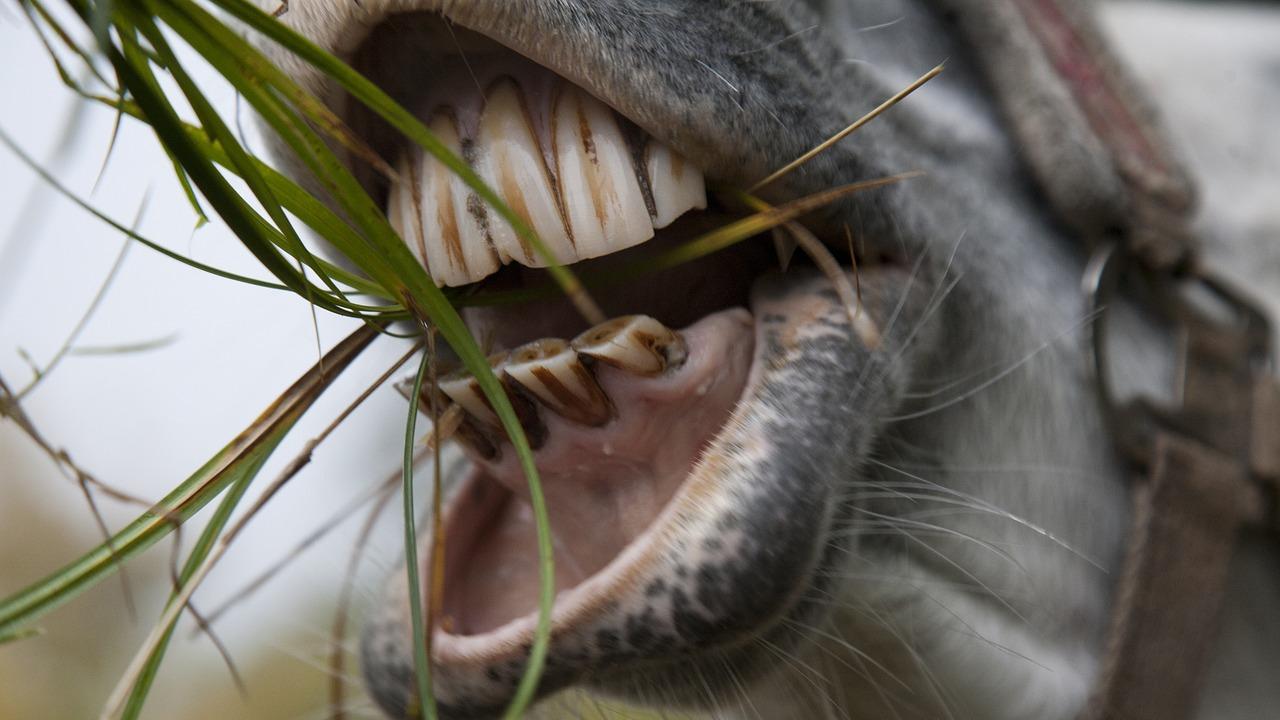
Equine Odontoclastic Tooth Resorption and Hypercementosis (EOTRH)
Takeaways
- Equine odontoclastic tooth resorption and hypercementosis (EOTRH) is a progressive dental condition in older horses that predominantly affects the incisors.
- The cause of EOTRH is unknown and is likely multifactorial.
- EOTRH is progressive, so clinical signs may not be apparent until the disease is at an advanced stage.
- Surgical removal of teeth and affected tissue may be recommended.
- The prognosis for horses after surgery is generally good, with many experiencing an overall improvement in quality of life.
What is equine odontoclastic tooth resorption and hypercementosis?
Equine odontoclastic tooth resorption and hypercementosis (EOTRH) is a progressive dental condition that occurs in some middle-aged and older equines. The disease involves two different cellular processes: 1) resorption/destruction of the tooth by specialized cells (odontoclasts) and 2) a proliferation of irregular cementum (the hard substance on the tooth’s surface that anchors it to the jaw) to try to stabilize the dissolving teeth. Resorption can occur without hypercementosis, but not the other way around.
Equine odontoclastic tooth resorption and hypercementosis most often affects permanent incisor (front teeth) and canine teeth, but also occasionally the premolars (first few teeth that are part of the grinding surface). Thoroughbreds and warmbloods over 15 years of age make up about half of the reported cases, but horses from any breed and sex can be affected. Cases showing the mild form of EOTRH have been reported in horses as young as ten years of age.
A definitive cause for EOTRH has not been determined, but it is likely multifactorial. Potential causes may include the presence of certain bacteria and other microorganisms in the mouth, environmental factors such as limited access to grazing, periodontal disease, concurrent health issues such as pituitary pars intermedia dysfunction (PPID), trauma from excessive dental procedures, type of feed, and genetics.
What are the clinical signs of equine odontoclastic tooth resorption and hypercementosis?
Clinical signs of EOTRH are variable depending on the stage and severity of the disease. Horses may not exhibit clinical signs in the early stages. Since EOTRH has a gradual onset, owners may not recognize the clinical signs until the condition becomes painful for the horse.
Subtle changes may include tooth discoloration and inflammation of the gums (which may appear red). Horses may not want to bite down on carrots or other treats, and may have difficulty grazing.
Horses with advanced disease may have difficulty chewing, frequent tooth fractures (incisors and/or canines), and painful, swollen gums. Ulcerations and draining tracts may appear around affected teeth. The base of affected, resorbed teeth may appear bulbous due to the buildup of cementum. Affected horses may exhibit difficulties chewing, bad breath, drooling, head shaking, quidding, and weight loss.
How is equine odontoclastic tooth resorption and hypercementosis diagnosed?
Equine odontoclastic tooth resorption and hypercementosis is diagnosed through a combination of veterinary dental examination, patient history, and radiographs. Radiological changes to the incisors are classified on a scale of 0 to 3, with 3 being the most severe.
It is important to note that EOTRH can occur concurrently or separately from periodontal disease and certain dental and oral infections, which can complicate diagnosis.
How is equine odontoclastic tooth resorption and hypercementosis treated?
For mild cases, regular care may include removal of feed accumulation between teeth, topical medications, antibiotics, pain management, and dietary modifications. However, there is currently no way to slow disease progression.
Surgical removal of teeth and affected tissues is recommended in severe cases, but potential complications can occur such as damage to surrounding tissues, infection, and other issues related to wound healing. Depending on the number and location of teeth that need to be removed, the tongue may protrude out of the mouth as a side effect after surgery. Non-steroidal anti-inflammatory drugs (NSAIDs) and antibiotics may be prescribed post-surgery to manage pain and prevent infection, along with dietary changes such as supplementation and senior feed that is soft and easy to chew.
What is the prognosis for equine odontoclastic tooth resorption and hypercementosis?
Most patients experience an overall improvement in quality of life after they recover from surgery. Depending on which teeth are extracted, horses may not require dietary changes since they use their cheek teeth to chew. Many learn how to graze even without their incisors by using their lips and tongue.
How can equine odontoclastic tooth resorption and hypercementosis be prevented?
Since the progression of EOTRH is variable from one individual to another, monitoring older horses annually by oral examination and taking radiographs every one to two years can be beneficial. Research into causes, treatment, and prevention are ongoing, but there are currently no definitive approaches to prevent EOTRH.
*This article may not be reproduced without the written consent of the UC Davis Center for Equine Health. Please email requests to cehadmin@ucdavis.edu.
